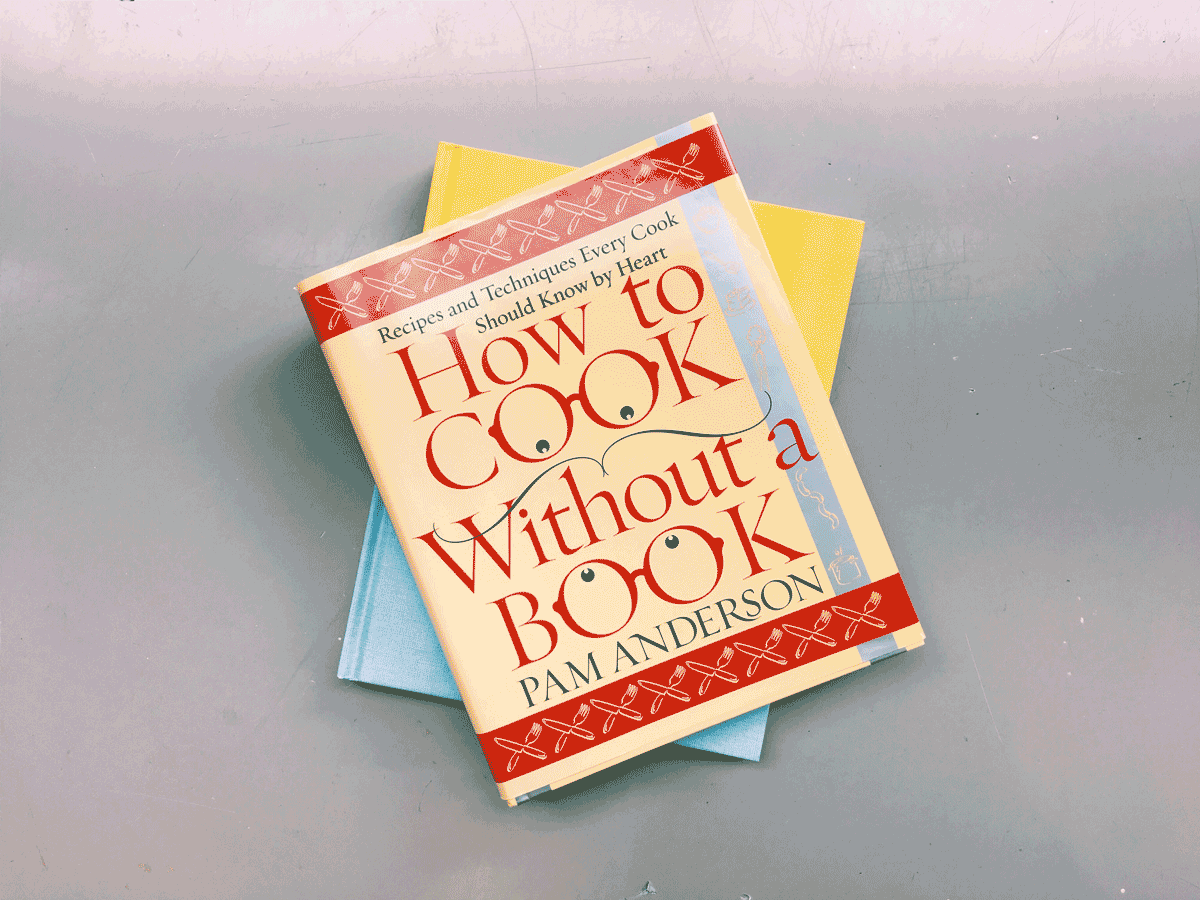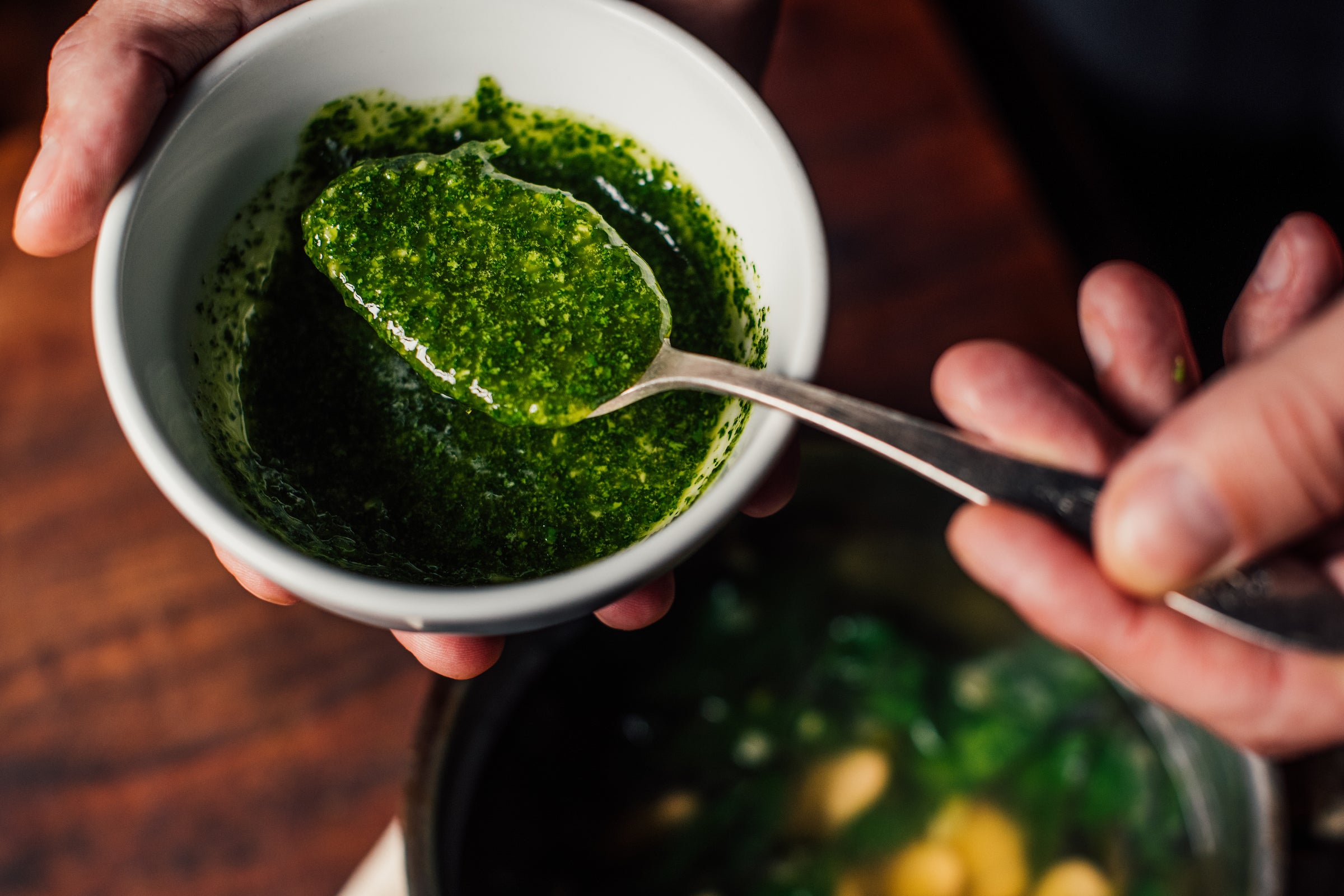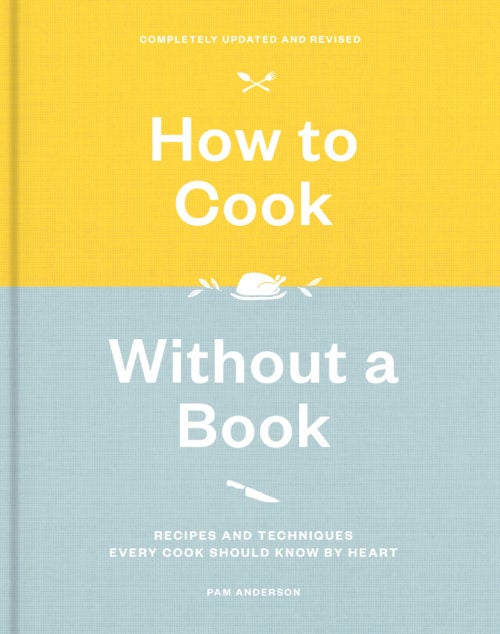Less Meat, More Kale: It’s How to Cook Without a Book 2.0

When the best-selling non-cookbook came out nearly 20 years ago, it proposed a new kitchen psyche for the new millennium. But the way we cook has changed a lot since then.
The whole concept might sound absurd on its surface—buying a cookbook that tells you that you don’t need a cookbook. But when Pam Anderson, a former editor from Cook’s Illustrated, published the first edition of How to Cook Without a Book in 2000, it quickly became a runaway hit and a New York Times best-seller.
The premise was simple: a set of techniques and templated recipes that would help you transform whatever you had lying around in your refrigerator into dinner. Leftover spiral ham? Here’s how to turn it into an omelet or a potato soup. Leftover cooked spaghetti? Here’s how to turn it into a pad Thai that will taste very different from the mushroomy pasta you ate last night. Rather than sending readers out on an obsessive hunt for a lengthy list of ingredients, the book was built around working with what you have, adapting, and building confidence around your own instincts in the kitchen.

Almost 20 years later, Anderson has released a completely revised edition, channeling the spirit of the original but updated to reflect everything that’s changed in American home cooking—and Anderson’s own home cooking—in the past 18 years. “When I first wrote How to Cook Without a Book,” says Anderson, “it was a moment of change in the way I needed to cook, and that’s always how I’ve known when it’s time to write a book.” Gone from the new edition are the chapters on potatoes, omelets, ravioli, and (cough) lasagna. There’s a little less meat and a little more kale. Also new to the scene are chapters on grain salads and one-roasting-pan meals.
For Anderson, these are changes reflecting not just the overall home-cooking zeitgeist, but the way she cooks in her own day-to-day life. “Occasionally I still do a protein-at-the-center-of-the-plate kind of meal,” she admits. “But now it’s more beans, grains, vegetables, one-pot, one-dish, one-sheet-pan, vegetable-heavy kinds of meals.”
It’s true. The same original sense of resourcefulness and practicality is present in the new book, but you can see a slight shift in the author’s worldview. In the original edition, a can of San Marzano tomatoes in the cupboard could mean a topping for chicken or an olive-filled pasta sauce. But in 2018, American cooking is about more than boneless chicken breasts and Mediterranean flavors. In the new edition, San Marzanos are a jumping-off point for a rich vodka sauce, or a tikka masala, or an African chicken stew with sweet potatoes and collards.
There are certain foods, of course, that American home cooks have been cooking for more than just the past 18 years and that they probably always will cook. From her own personal repertoire, Anderson is pretty sure she’ll never get sick of the Union Square Café bar nuts, spaghetti Bolognese, chicken noodle soup, simple tomato sauce, and bread.
But there are a few holdovers from the 1990s that Anderson is ready to phase out. For one: diets that hinge on animal protein. “That’s not a sustainable way of life, and it’s not good for the planet,” she says. The other one is what Anderson describes as a fear of food. “That’s a trend I’d like to see go away,” she says. “Food should be pleasurable, something that unites us.”
Photo by Denny Culbert
Ingredients
- Bolognese
- 2 ounces (4 thin slices) proscuitto, minced
- Olive oil
- 1 pound meatloaf mix (a mix of pork, veal, and beef)
- 1 quart Vegetable Tomato Sauce
- ¼ cups heavy cream
- Vegetable Tomato Sauce
- ½ cups olive oil
- 2 medium onions, diced
- 2 carrots, diced
- 2 celery stalks, diced
- 1 teaspoon red pepper flakes
- 4 cans (28 ounces each) crushed tomatoes or whole tomatoes packed in puree (not juice!)
- 1 cup red or white wine or water
- Salt and ground black pepper
- 1 can (6 ounces) tomato paste
On a busy night, you can take one of the quarts of Simple Tomato Sauce and use it as a base to build an interesting sauce to serve over pasta, a surprising stew to ladle over rice, or a comforting soup made complete with a warm baguette.
Cook up some pasta, gnocchi, or ravioli. Once you’ve drained the cooked pasta, return it to the pot, toss it with one-third of the sauce, and divide among 4 pasta plates. Top each with a portion of the remaining sauce, a sprinkling of Parmesan cheese (preferably Parmigiano-Reggiano), and a little drizzle of extra-virgin olive oil. Each generous quart container of sauce is enough for 12 to 16 ounces of pasta—enough to serve 4 or 5 people.
You can use ground beef or bulk Italian sausage in place of the meatloaf mix.
Vegetable Tomato Sauce
- Heat the oil in a large pot over medium-high
heat. Add the onions, carrots, celery, and pepper flakes and cook until vegetables soften, 5 to
7 minutes.
- Stir in the tomatoes. Use the wine or water to rinse out the cans and add to the pot. Bring
to a simmer, then reduce the heat to medium-low and simmer, partially covered, until the
sauce thickens and the flavors meld, about 15 minutes. Taste the sauce and season with salt
and pepper to taste. Add enough tomato paste so that you’ve made a thick, full-bodied sauce,
not soup (see Note). Simmer to blend the flavors, a few minutes longer. Cool the sauce and
divide it among 3 sealed containers. (Can be refrigerated for a couple of weeks or frozen for
several months.)
Bolognese
- Cook: 2 ounces (4 thin slices) prosciutto,
minced, in a couple of teaspoons olive oil in
large saucepan or small pot over mediumhigh
heat until they turn brown, a couple of
minutes.
- Add: 1 pound meatloaf mix (a mix of pork,
veal, and beef). Cook until it loses its raw
color, then spoon off excess fat. Add a
generous quart Vegetable Tomato Sauce and simmer until the sauce thickens,
about 10 minutes.
- Stir in: ¼ cup heavy cream and simmer
a couple of minutes longer. Adjust the
seasonings and serve.
Ingredients
- 6 large boneless, skinless chicken thighs
- Olive oil
- Salt and ground black pepper
- 1 ½ teaspoons ground coriander
- 1 ½ teaspoons ground cumin
- 1 medium onion, diced
- 2 tablespoons grated fresh ginger
- 2 tablespoons garam masala
- 1 quart Garlicky Tomato Sauce
- 1 cup coconut milk
- ¼ cups chopped fresh cilantro
- Garlicky Tomato Sauce
- ½ cups olive oil
- 12 large garlic cloves
- 1 teaspoon red pepper flakes
- 4 cans (28 ounces each) crushed tomatoes or whole tomatoes packed in puree (not juice!)
- 1 cup red or white wine or water
- Salt and ground black pepper
- 1 can (6 ounces) tomato paste
When you realize that tomato sauce is really just cooked tomatoes, oil, and aromatics, you start to see it can be used as a base for dishes far beyond Italian-inspired. Having a quart of cooked tomato sauce not only gives you a head start on the ingredient prep, but also reduces cooking time since you’re starting with a rich, reduced base. Change the spice profile, add a few different ingredients, and sub in rice for the pasta and you’ve got a completely different meal from the one the night before. Serve with ¾ to 1 cup of cooked rice per person.
The tubed ginger paste that you find in the refrigerated section of many produce departments is a good shortcut here.
Garlicky Tomato Sauce
- Heat the oil, garlic, and pepper flakes in a large
pot over medium-high heat until the garlic starts to sizzle, just a couple of minutes.
- Stir in the tomatoes. Use the wine or water to rinse out the cans and add to the pot. Bring to a simmer, then reduce the heat to medium-low and simmer, partially covered, until the sauce thickens and the flavors meld, about 15 minutes. Taste the sauce and season with salt and pepper to taste. Add enough tomato paste so that you’ve made a thick, full-bodied sauce, not soup. Simmer to blend the flavors, a few minutes longer. Cool the sauce and divide it among 3 sealed containers. (Can be refrigerated for a couple of weeks or frozen for several months.)
Chicken Tikka Masala
- Cook: the skinned side of 6 large boneless, skinless chicken thighs that have been oiled, salted, peppered, and sprinkled with 1½ teaspoons ground coriander, and 1½ teaspoons ground cumin in a large pot over medium-high heat until browned, about 5 minutes.
- Turn the chicken and add: 1 diced medium onion and 2 tablespoons grated fresh ginger and cook a minute or two longer. Add 2 tablespoons garam masala, 1 quart Garlicky Tomato Sauce (page 117), and 1 can (13.5 ounces) coconut milk. Bring to a simmer and continue to simmer for 10 minutes to blend the flavors. Adjust the seasonings, stir in ¼ cup chopped fresh cilantro, and serve.




